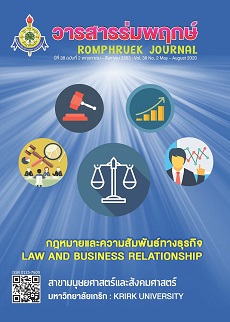Differential Application of OMO Model in Tourism Shopping
Main Article Content
Abstract
Changes in consumer demand and the development of retail infrastructure have promoted the emergence of the OMO (Online-Merge-Offline) model, which has become an effective way to resolve online and offline purchase conflicts. This study combines the characteristics of travel shopping and industry expert interviews to summarize the performance of the fusion dilemma that occurs when the OMO model is applied in the travel shopping market. Based on this, an OMO model that integrates the dilemma factors in the process of tourism shopping is differentiated and designed the model application process. The differentiated application of the OMO model transforms the precise flow of offline travel shopping, reconstructs customer consumption experience, extends offline consumption scenarios, enhances sales work motivation, and enhances the brand recognition of businesses, and effectively improves the sales performance of travel shopping businesses.
Article Details
Every article published in the Romphruek Journal of the Humanities and Social Sciences is the opinion and point of view of the authors. Thery're not the viewpoint of Krirk University or the editored department. Any part or all of the articles for pablication must be clearly cited.
References
Andrea Chang. (2010). Retailers Fuse Stores with E-commerce. (February 13, 2013)
Retrieved From https://www.tuscaloosanews.com/business/20100627/
retailers-fuse-stores-with-e-commerce.
Chen, X.Y. (2010). Goods management in the development of enterprise e-commerce channels.
China Business & Trade, 23, 85-86.
Dou, K. (2017). How to integrate marketing channels in the e-commerce era.
Foreign Investment in China, 9, 86-88.
Fu. B. (2019). Reflections on the OMO Business Model in the Age of the Internet Economy.
Reformation & Strategy, 35(7), 75-83. DOI:10.16331/j.cnki.issn1002-736x.2019.07.010
Gee, C.Y, Maken, J.C & Choy, D.J. (1997). The travel industry. New York : Van Nostrand Reinhold.
Guo, Y, Wang, K. & Chen, G.H. (2015). Research on Traditional Retalier’s Transformation and
Upgrading Base on Online and Offline Integration.
Chinese Journal of Management Science, 23(S1), 726-731.
Jonathan Nelson. (2013). One Screen to Rule Them All. (February 13, 2013) Retrieved from
https://www.adweek.com/brand-marketing/voice-one-screen-rule-them-all-147137/.
Law, R. & Au, N. (2000). Relationship modeling in tourism shopping : a decision rules induction
approach. Tourism Management, 21(3), 241-249.
Li, J.F. (2013). The use of social media in product marketing. The School of Communication at
Jiangxi Normal University, Nanchang in China.
Li, K.F. (2018). Speeding towards the OMO era. Journal of Manager, 2, 144-146.
Li, X.Y. & Zhang, L.P. (2009). Thoughts on the integrity of tourism shopping. Journal of Wuhan
Commercial Service College, 23(03), 37-38.
Nie, H.G. (2003). Tourist Consumption Psychology and Tourist Product Development.
Journal of Guizhou College of Finance and Economics, 1, 65-67.
Pan,Y. (2017). Research on the Operating Model of Chain Retail Enterprises Based on O2O
Model. Mall Modernization Journal, 23, 24-25. DOI:10.14013/j.cnki.scxdh.2017.23.014.
Shi, M.Y. (2005). A Study on Shopping Behaviors of Tourists. Tourism Tribune, 5, 70-75.
Shi, P. & Long, Y. (2018). Service Quality Decision-making in Tourism O2O Supply Chains
Considering Service Costs-Sharing. Tourism Tribune, 33(11), 87-97.
DOI:10.3969/j.issn.1002-5006.2018.11.015.
Shi, Y.F. & Zhang, H. (2016). Reflections on the OMO Business Model in the Age of the Internet
Economy. Journal of Commercial Economics,13, 7-10.
Sun, Y.N. (2018). Game Analysis of O2O Model in Tourism Shopping.
E-Business Journal, 4, 9-10. DOI:10.14011/j.cnki.dzsw.2018.04.005.
Wang, X.H. & Zhang, Q.L. (2013). Research on Online and Offline Marketing Synergy of Multi-
channel Retailers—Case Study on Suning. Journal of Business Economics, 9, 37-47.
DOI:10.14134/j.cnki.cn33-1336/f.2013.09.010.
Xia, Q.H. & Feng, Y. (2016). The Conflict and Coordination of Traditional Retailing Enterprises
about Online and Offline Dual Business Model Innovation—In the Case of Suningyun. Economy and Management, 30(01), 64-70.
Yang, X. (2018). Reflections on the OMO Business Model in the Age of the Internet Economy.
Contemporary Economics, 17, 94-95.
You, H. & Tao, Z.M. (2006). Problems and Optimization of China Tourism Consumption
Structure . Jiangsu Commercial Forum, 8, 62-63. DOI:10.13395/j.cnki.issn.1009-0061.2006.08. 024
Zhao, L.M, Wang, M., Xin, C.X. & Wang, G. (2002). Impact of Information Asymmetry on Tourism
Commodity Market and Its Governance Strategy.
Journal Beijing Second Foreign Language Institute, 1, 1-3.
Zhong, Z.P. (2005). Tourism Shopping Theory and Development Practice. Beijing,
China : china market publishing corp.


